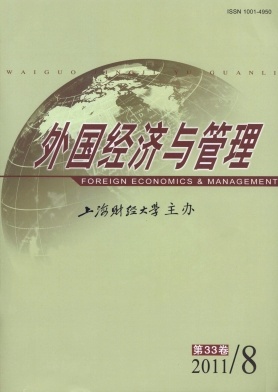国外员工变革反应研究综述
外国经济与管理 2011 年 第 33 卷第 08 期, 页码:41 - 49
摘要
参考文献
摘要
员工对变革的反应对于组织变革的成功至关重要,微观、个体层面的研究正取代宏观、系统层面的研究成为组织变革研究的焦点。本文对员工视角的组织变革研究进行了梳理,对员工变革反应的类型、影响因素和形成机制进行了分析,并指出了现有研究对组织变革管理的启示以及未来的研究方向。
[1]Ford,J D,Ford,L W,and Amelio,A D.Resistance to change:The rest of the story[J].Academy of Management Review,2008,33(2):362-377.
[2]Herold,D M,Fedor,D B,and Caldwell,S D.Beyond change management:A multilevel investigation of contextual and personal in-fluences on employees’commit ment to change[J].Journal of Applied Psychology,2007,92(4):942-951.
[3]Judge,T A,Thoresen,C J,Pucik,V,and Welbourne,T M.Managerial coping with organizational change:Adispositional perspec-tive[J].Journal of Applied Psychology,1999,84(1):107-122.
[4]Furst,S A,and Cable,D M.Employee resistance to organizational change:Managerial influence tactics and leader-member ex-change[J].Journal of Applied Psychology,2008,93(2):453-462.
[5]Piderit,S K.Rethinking resistance and recognizing ambivalence:A multidi mensional view of attitudes toward an organizationalchange[J].Academy of Management Review,2000,25(4):783-794.
[6]Oreg,S.Personality,context,and resistance to organizational change[J].European Journal of Work and Organizational Psychol-ogy,2006,15(1):73-101.
[7]Herscovitch,L,and Meyer,J P.Commit ment to organizational change:Extension of a three-component model[J].Journal of Ap-plied Psychology,2002,87(3):447-487.
[8]Herold,D M,Fedor,D B,Caldwell,S,and Liu,Y.The effects of transformational and change leadership on employees’commit-ment to a change:A multilevel study[J].Journal of Applied Psychology,2008,93(2):346-357.
[9]Wanberg,C R,and Banas,J T.Predictors and outcomes of openness to changesin a reorganizing workplace[J].Journal of AppliedPsychology,2000,85(1):132-142.
[10]Wanous,J P,Reichers,A E,and Austin,J T.Cynicism about organizational change[J].Group&Organization Management,2000,25(2):132-153.
[11]Stanley,DJ,Meyer,J P,and Topolnytsky,L.Employee cynicismand resistance to organizational change[J].Journal of Businessand Psychology,2005,19(4):429-459.
[12]Terry,DJ,and Callan,VJ.Employee adjust ment to an organizational change:Astress and coping perspective[A].in P Dewe,MLeiter,and T Cox(Eds.).Coping,health,and organizations[C].London,Britain:Taylor&Francis,2000:259-276.
[13]Fedor,D B,Caldwell,S,and Herold,D M.The effects of organizational changes on employee commit ment:A multilevel investiga-tion[J].Personnel Psychology,2006,59(1):1-29.
[14]Peccei,R,Giangreco,A,and Sebastiano,A.The role of organizational commit ment inthe analysis of resistance to change:Co-pre-dictor and moderator effects[J].Personnel Review,2011,40(2):185-204.
[15]Michaelis,J,Stegmaier,R,and Sonntag,K.Affective commit ment to change andinnovationi mplementation behavior:The role ofcharismatic leadership and employees’trust in top management[J].Journal of Change Management,2009,9(4):399-417.
[16]Allen,J,Ji mmieson,N L,Bordia,P,and Irmer,B E.Uncertainty during organizational change:Managing perceptions throughcommunication[J].Journal of Change Management,2000,7(2):187-210.
[17]Rafferty,A E.The i mpact of change process and context on change reactions and turnover during a merger[J].Journal ofManagement,2010,36(5):1 309-1 338.
[18]Oreg,S.Resistance to change:Developing anindividual differences measure[J].Journal of Applied Psychology,2003,88(4):587-604.
[19]Machin,M A,Fogarty,GJ,and Bannon,S F.Predicting employees’commit ment to and support for organizational change[J].The Australian and New Zealand Journal of Organizational Psychology,2009,2(1):10-18.
[20]Liu,Y,and Perrewé,P L.Another look at the role of emotioninthe organizational change:Aprocess model[J].Human ResourceManagement Review,2005,15(4):263-280.
[2]Herold,D M,Fedor,D B,and Caldwell,S D.Beyond change management:A multilevel investigation of contextual and personal in-fluences on employees’commit ment to change[J].Journal of Applied Psychology,2007,92(4):942-951.
[3]Judge,T A,Thoresen,C J,Pucik,V,and Welbourne,T M.Managerial coping with organizational change:Adispositional perspec-tive[J].Journal of Applied Psychology,1999,84(1):107-122.
[4]Furst,S A,and Cable,D M.Employee resistance to organizational change:Managerial influence tactics and leader-member ex-change[J].Journal of Applied Psychology,2008,93(2):453-462.
[5]Piderit,S K.Rethinking resistance and recognizing ambivalence:A multidi mensional view of attitudes toward an organizationalchange[J].Academy of Management Review,2000,25(4):783-794.
[6]Oreg,S.Personality,context,and resistance to organizational change[J].European Journal of Work and Organizational Psychol-ogy,2006,15(1):73-101.
[7]Herscovitch,L,and Meyer,J P.Commit ment to organizational change:Extension of a three-component model[J].Journal of Ap-plied Psychology,2002,87(3):447-487.
[8]Herold,D M,Fedor,D B,Caldwell,S,and Liu,Y.The effects of transformational and change leadership on employees’commit-ment to a change:A multilevel study[J].Journal of Applied Psychology,2008,93(2):346-357.
[9]Wanberg,C R,and Banas,J T.Predictors and outcomes of openness to changesin a reorganizing workplace[J].Journal of AppliedPsychology,2000,85(1):132-142.
[10]Wanous,J P,Reichers,A E,and Austin,J T.Cynicism about organizational change[J].Group&Organization Management,2000,25(2):132-153.
[11]Stanley,DJ,Meyer,J P,and Topolnytsky,L.Employee cynicismand resistance to organizational change[J].Journal of Businessand Psychology,2005,19(4):429-459.
[12]Terry,DJ,and Callan,VJ.Employee adjust ment to an organizational change:Astress and coping perspective[A].in P Dewe,MLeiter,and T Cox(Eds.).Coping,health,and organizations[C].London,Britain:Taylor&Francis,2000:259-276.
[13]Fedor,D B,Caldwell,S,and Herold,D M.The effects of organizational changes on employee commit ment:A multilevel investiga-tion[J].Personnel Psychology,2006,59(1):1-29.
[14]Peccei,R,Giangreco,A,and Sebastiano,A.The role of organizational commit ment inthe analysis of resistance to change:Co-pre-dictor and moderator effects[J].Personnel Review,2011,40(2):185-204.
[15]Michaelis,J,Stegmaier,R,and Sonntag,K.Affective commit ment to change andinnovationi mplementation behavior:The role ofcharismatic leadership and employees’trust in top management[J].Journal of Change Management,2009,9(4):399-417.
[16]Allen,J,Ji mmieson,N L,Bordia,P,and Irmer,B E.Uncertainty during organizational change:Managing perceptions throughcommunication[J].Journal of Change Management,2000,7(2):187-210.
[17]Rafferty,A E.The i mpact of change process and context on change reactions and turnover during a merger[J].Journal ofManagement,2010,36(5):1 309-1 338.
[18]Oreg,S.Resistance to change:Developing anindividual differences measure[J].Journal of Applied Psychology,2003,88(4):587-604.
[19]Machin,M A,Fogarty,GJ,and Bannon,S F.Predicting employees’commit ment to and support for organizational change[J].The Australian and New Zealand Journal of Organizational Psychology,2009,2(1):10-18.
[20]Liu,Y,and Perrewé,P L.Another look at the role of emotioninthe organizational change:Aprocess model[J].Human ResourceManagement Review,2005,15(4):263-280.
引用本文
朱其权, 龙立荣. 国外员工变革反应研究综述[J]. 外国经济与管理, 2011, 33(8): 41–49.
导出参考文献,格式为:
上一篇:国外精神型领导研究述评





 7703
7703  999
999

